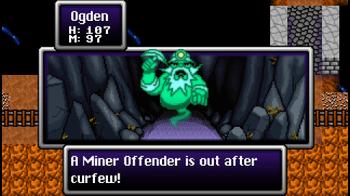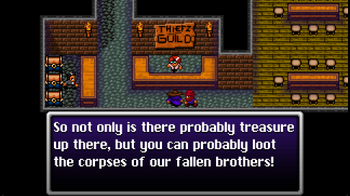
Dragon Fantasy Book I Review
If there’s two things I could say about the things indie RPGs have been doing in the last few years, I’d say that they were “retro” and “humorous”. Most of these RPGs tend to stay away from the high-tech graphics from the current generation and instead focus on the 8-bit and 16-bit graphics of the old, and many times considered ‘golden’ days of gaming. At the same time, though, most of these “old-school” games also tend to make fun of the genre they themselves are a part of. This leads to varying amounts of success--many people love Cthulhu Saves the World, for example, but there are plenty of other RPGs that try to be funny but are more or less forgotten in the crowd.
As you might expect, Dragon Fantasy Book I, a PS3/Vita port of an iOS/Android title, is an RPG trying to mix retro with humor successfully. Is this enhanced port a memorable indie RPG, or another title that falls flat?
Dragon Fantasy Book I is split into three episodes, with a non-canon intermission to round out the experience. You can play these in any order, but it’s recommended that you go in order, lest you not understand certain plot details. Despite the story being split up the way it is, the game itself is quite short, lasting anywhere between eight to twelve hours depending on your play style. Also, Book I is a cross-buy and cross-save title between the PlayStation 3 and Vita, allowing you to be able to continue the adventure on the go or at home.
As for the plot, most of it is revealed in Episode 1, which also happens to be the longest and most difficult of the three. An evil knight attacks Westers, and it’s up to formally retired knight Ogden to stop the new threat upon the world. It’s a pretty typical, light plot, but enough of one to get you to the end of the game efficiently enough.
Ogden, being the honor bound knight he is, never gathers any other party members during his tale; instead, it’s very much like the original Dragon Warrior in which he’s practically a one-man army. Ogden has a wide range of spells at his disposal (though his weapon will almost always be the best method of attack), and fights all of his enemies on a one-versus-one scenario.
Of course, with Ogden’s episode being structured like the oldest of JRPGs, his part of Dragon Fantasy requires the most grinding. You’ll be able to easily tell when you’re underpowered, and the only way to solve that is to level up and grind for better gear. This might be a point of frustration for those used to modern RPGs, but you rarely have to grind for an extended period beyond the first area, so it never really becomes intrusive of the experience.
Even when you do have to grind, there’s an option available to help make it so by faster. Pressing Select makes the game go into Turbo Mode, in which everything goes back extremely quickly (and makes your play time skyrocket). Using the Turbo Mode to get another level or walk back to that area of the dungeon again makes backtracking and grinding relatively painless, but you also have to be careful: Going too fast might have you not noticing Ogden’s diminishing health and you might wind up back in a church with half of your earnings gone.
While Ogden’s tale is the largest and most representative of Dragon Fantasy itself, the other episodes are well worth playing, despite their much shorter nature. The second episode revolves around Anders, Prince of Westers and brother of the previously mentioned Marlon, the other prince. Anders’ tale has him going to an icy cave to investigate rumors about the locale, in hopes of finding something to help rescue Marlon.
Anders, however, is not much of a fighter, so he has to recruit help from elsewhere. You can recruit two other party members (and even a secret third member if you find him), giving you a well-rounded party to tackle the threats ahead. Battles are still against only one enemy though, so when your levels catch up it’s a bit on the easy side.
However, the chance to explore a few new areas and fight new enemies is great, because where Dragon Fantasy’s humor comes through and shines is in the battles. While the story takes itself (mostly) seriously, the battle text does not, instead replacing things like “Wolfman is defeated” with “Wolfman turns into a cold, scared, naked guy”. Enemies don’t just attack you: They make fun of your hair, poke your neck with a straw, and nag at you. This adds a humorous and fun air to an aspect of an RPG that is usually seen as the most mundane.
Anders’ episode indirectly leads to the third episode, starring Jerald in a whole new country to explore. The area of Sandheim is a bit more open than the previous’ episodes were, and you can choose to tackle the jobs the Thiefz Guild in any order to accumulate the 20,000 gold needed to get out of the desert.
Jerald and his niece Ramona have a different threat to face, however… now enemies come in groups, and they’ll have to employ new skills to survive against the enemy swarms. Then again, none of the jobs in particular have any boss battles attached, so Jerald could easily go through the episode with minimal fighting. Episode 3 gives you the framing device for Dragon Fantasy Book II, and also a bit of a cliffhanger to look forward to in the next game.
The Intermission is a non-canon story that pays tribute to Minecraft, and gives you a taste of capturing monsters and using them to fight, as well as a rudimental crafting system. Both of these aspects are a part of Dragon Fantasy Book II, so it gives a nice preview of things to come. It is, however, very short--it is only an intermission, after all!
Overall the game itself holds itself well to old-school asthenics. If you play the game in its original mode, you’ll be treated to authentic 8-bit graphics and sound. The PS3/Vita version also has the option to use enhanced graphics and sound, which gives the game a more 16-bit look. Both options look pretty great, and lend itself to the game well.
The game itself, being an old-school RPG, for the most part plays well, but there are a few hiccups in the design that, while not gamebreaking, are pretty odd. There’s an Auto-Save feature, and while it’s helpful, often times it’s not caught up with your current save… which is a problem when the game tries to have you load the auto-save automatically. Also, I ran into a couple glitches during the course of the game--Once in Episode 1 I wasn’t able to move anyway but right until I got into a battle, and in Episode 2 while fighting a boss my spells and items disappeared in the midst of battle. While neither of these are game-breaking (though the second could have ended badly), the odd quirks of the game do seem out of place in an overall well-designed title.
Is Dragon Fantasy Book I a retro tribute to the genre’s influential games? Yes. Is it humorous? Yes, but it doesn’t quite beat you over the head with it. Is it worth a try? Definitely. Dragon Fantasy Book I is retro all the way, and any old-school RPG fan should give it a try to reminisce about the olden days.



